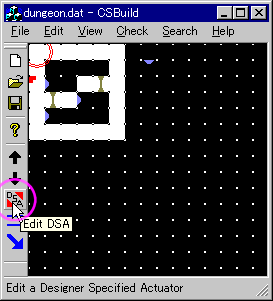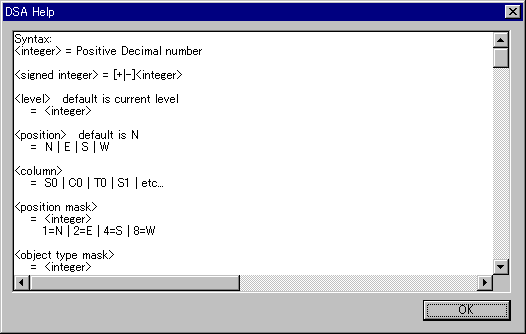| "M" is the operator. "T" and "A" are parameters. |
Summary
Parsing "MTA"
| |||
| You always check the reference to write DSA program, also trial and error. |
"M" means "standard Message".
"T" means message type "Toggle".
"A" means message target is pointed by "Parameter A".
"MTA" is converted into "MT". because "A" is default parameter, it is just omitted.
Currently 2 or 3 sources available
Reference by Paul Stevens:
| |||||
Reference by kentaro-k.21 (available at this site):
|
Note: most part of my reference is rewrite from Paul's reference.
From my reference, look at Operations syntax section in DSA reference.

"2. standard Message" is that.
[<next state>] "M" [<delay>]
<message type> [<target>] |
This representation is formatted by quasi BNF syntax. (See also: http://en.wikipedia.org/wiki/Backus-Naur_form)
<next state> is omittable because enclosed by "[" and "]". So, it is omitted. By omitting, running is continued at current state.
<delay> is also omittable. By omitting, no delay occurs.
<message type> is message type. Select one of "N" / "S" / "C" / "T". You cannot omit it.
<message type> :: = "N" |
"S" | "C" | "T"
|
<target> specify message's destination. You can omit it.
In our case, "Parameter A" points the door. We placed a DSA actuator with such a parameter. So, use "A".
But "A" is default selection according to grammer description. So CSBuild may omit "A", you'll see only "MT" in next editing time.
<target> :: = "A" | "B" |
"*" | <absolute location>
|
| Rain` has posted some DSA samples can be run immediately with CSBwin. But their useful samples seem to be off-line for now. Sample DSA and CSbuild bug report |
Launch CSBuild.

Click "Edit DSA", and find the following widow, then click "Help" button.

You'll get next window. Copy this text, and have your own text for easy reference.
